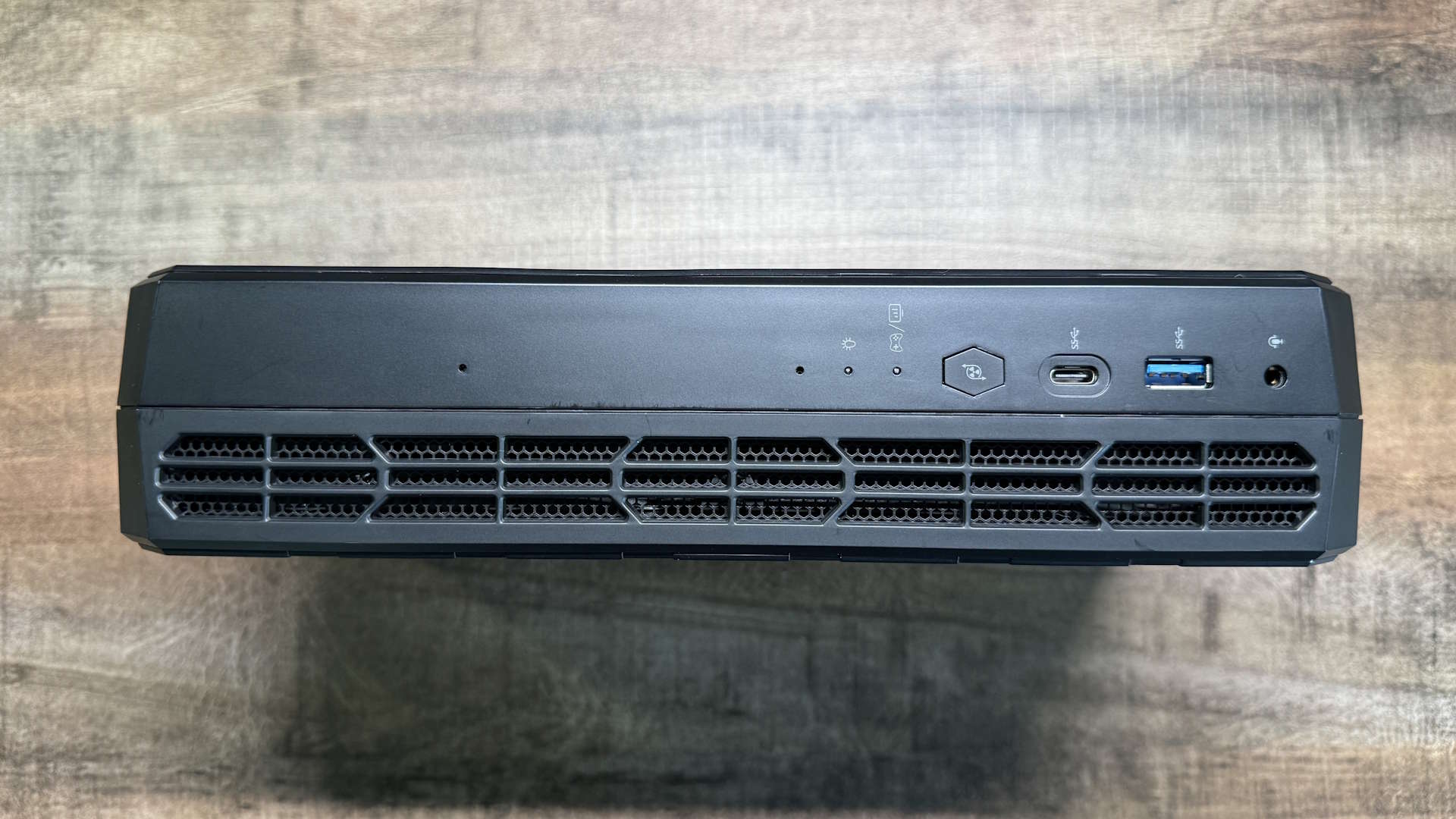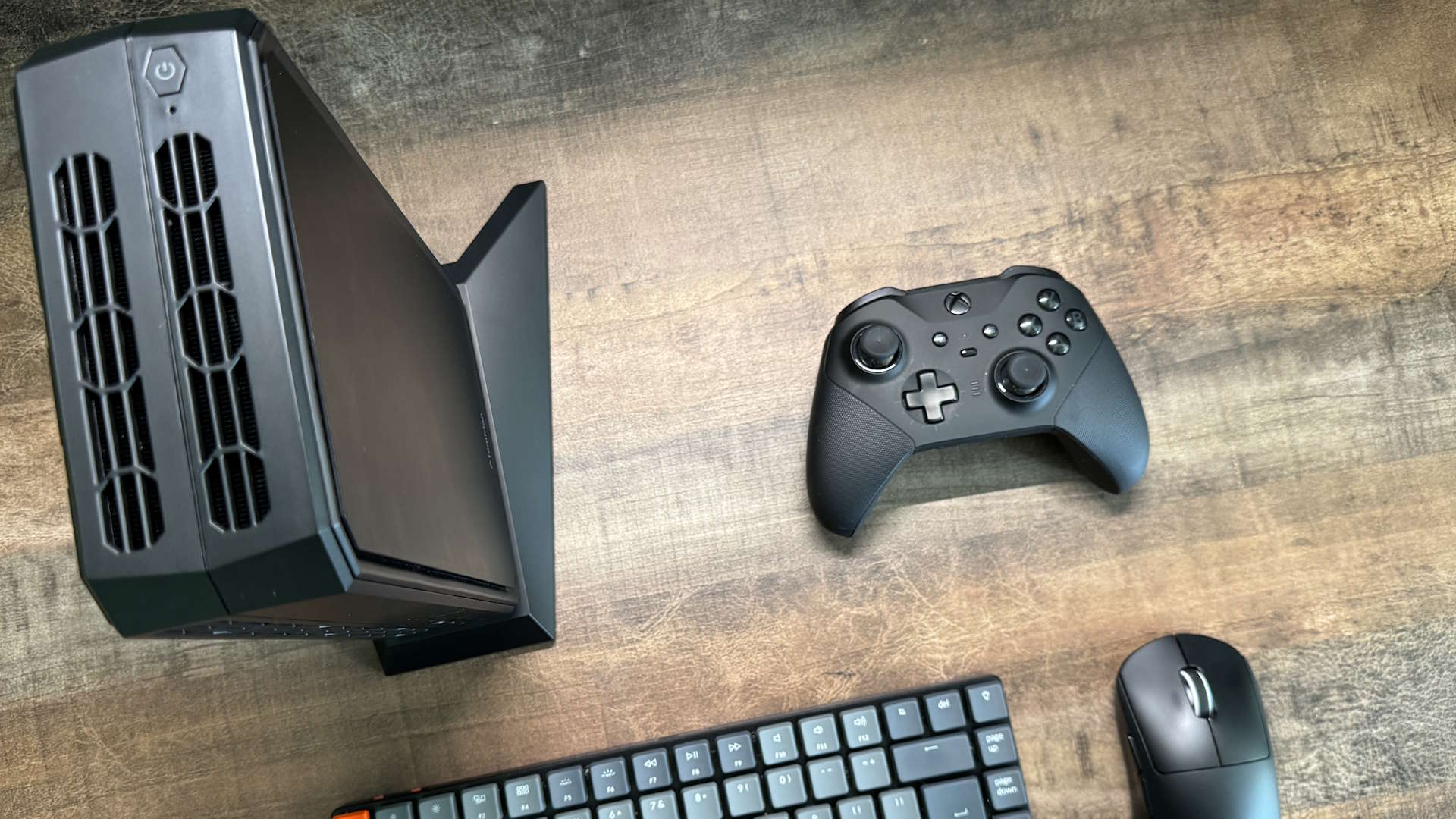Our Verdict
Capable of 1440p gaming, but pair this little bad boy with a 100Hz+ 1080p panel and you’re in high-frame rate heaven.
For
- Fabulous 1080p performance
- Abundant CPU power
- Cool, quiet and competent
Against
- Some games are a stretch at 1440p
- Doesn’t handle ray tracing well
PC Gamer's got your back
Quite how AMD classes the Ryzen 9 7945HX as a mobile chip is beyond me. The clue's in that HX-suffix: H stands for 'high-performance mobile APU', and X stands for 'Extreme', which broadly signifies higher clock speeds and greater power consumption than your common-or-garden Ryzen APU.
What this translates to is 16 cores, 32 execution-threads and a max turbo clock speed of 5.4GHz. AMD rates this little hellion to run at 45-75 W, but apparently, that isn't quite enough for Minisforum. Set to Performance Mode, the AtomMan G7 PT shovels a hefty 85 W into the 7945HX.
Does that make sense in a mini-PC? Those sorts of figures would send any self-respecting laptop manufacturer running for the hills, wailing "kill the TDP! Kill it or WE'RE ALL DOOOOMED!" But the AtomMan G7 PT is a desktop machine, so mobility isn't a factor. It has its own 300 W external PSU, there's no battery to run down, and the chip gets Minisforum's proprietary, NASA-grade cooling to keep it in line. So why the hell not, I guess?
Running in tandem is AMD's Radeon RX 7600M XT, a discrete RDNA3 mobile GPU most commonly found improving frame rates in notebooks and portable eGPU boxes such as the OneXGPU. It features 2048 shader units, 32 CUs, an aggregated memory bus of 128-bit, clocks up to 2600 MHz and comes with 8 GB of dedicated GDDR6 VRAM. It's a solid step-up from its predecessor, the RX 6600M, and a major leap from the Radeon 780M iGPU, which many APU-driven micro-machines lean on for gaming. However, it can't quite match the wellie of the mobile RTX 4070, which we see powering other offerings in this discrete-GPU-packing branch of the mini-PC family tree.

CPU: AMD Ryzen 9 7945HX
GPU: Radeon RX 7600M XT
Memory: Up to 96 GB DDR5 5200MHz SODIMM
Storage: 1x PCIe 5 port, 1x PCIe 4 port
Wireless: WiFi 7, Bluetooth 5.3
I/O: front: 1x USB 3.2 Gen 2 Type-A, 1x USB 3.2 Gen 2 Type-C, 3.5mm combo jack
I/O rear: 1x HDMI 2.0, 1x DisplayPort 2.0, 3x USB 3.2 Gen 2 Type-A, 1x USB 3.2 Gen 2 Type-C, 2.5G LAN, 3.5mm audio and mic jacks
Price: $999 | £989 (barebones)
From the outside, the AtomMan G7 PT is roughly the length and volume of a couple of Steam Decks smooshed face-to-face. It ships with a vertical stand, which you should definitely use as the cooling fans sit beneath each of the side-panels—laying it flat will almost certainly leave it gasping for breath. The stand itself is strongly magnetised, and the machine connects to it with a snug and physically satisfying snap. In its natural tower orientation, the G7 PT's desktop footprint is very modest.
Attached to the underside of the right-hand case panel you'll find a shine-through sheet, which is positioned above a pair of large square LEDs mounted in the main body. This arrangement serves to illuminate the logo for Legend of Asaku, a popular Taiwanese entertainment IP, when the machine is powered on. Being unfamiliar with the series—and if I'm honest, becoming somewhat distracted by the constant colour-switching—I was happy to find an LED toggle in the BIOS.
It's on or off though, there are no other LED customisation options which is a shame. The logo sheet is removable, and I imagine you could supply its dimensions, plus an image of your choice, to an online etching service and have your own panel-art made up if you're so inclined.
The rest of the spec sheet is great. It supports two M.2 drives (one PCIe 5 and one PCIe 4), is Wi-Fi7 and Bluetooth 5.3 compliant, and can take up to 96 GB of DDR5-5200 in the SODIMM format. For video output at the rear, you get HDMI 2.1, DisplayPort 2.0, and a USB 3.2 Gen2 Type-C socket, which can also be used for charging and data transfer. Below this are three USB 3.2 Gen2 Type-A sockets, a 2.5G LAN port, and separate 3.5mm audio and mic jacks. Up front, you get another USB-C, another USB 3.2 Type-A, a 3.5mm combo jack for audio, and a performance mode button, which toggles the 7945HX and its attendant cooling solution between two TDP presets.



In the default Balanced mode, the machine runs the CPU at a TDP of 65 W. Tapping the button instantly bumps this to the 85 W Performance mode, no restart required. Naturally this comes with a rise in heat generation and fan activity. It basically goes from near-silent at 65 W to a bit windy—though with no coil-whine—at 85 W. Like the AtomMan X7 Ti, Minisforum's Cold Wave phase-change cooling tech once again proves its worth by keeping fan noise to a minimum, while completely taming the heat generation of a high-TDP mobile chip. During our Cinebench multicore test, 65 W saw the 16-core 7945HX chilling at 69 °C. Hiking the TDP to 85 W nudged the temperature up to just 83 °C.
But what does that extra 20 W get you performance-wise? Actually very little in gaming terms, as our benchmarks show. More CPU-dependent titles will see a rise in frame rates—remarkably so in Homeworld 3's case—but for the vast majority of games, there's no difference at all between the two modes. With so much CPU power on tap even at 65 W, gaming frame rates are almost exclusively GPU-bound. So our advice is to leave it in Balanced mode for gaming. It's so quiet you'll forget it's even there.
CPU-intensive productivity workloads are where you'll see benefits at 85 W. In the likes of Cinebench and Blender, the 7945HX beats all the other APU-driven mini-PCs we've tested—even those armed with the likes of the Ryzen 9 8945HS and the Intel Core ultra 9 185H—into a cocked hat. It even outperforms my desktop Ryzen 9 7900, for Pete's sake. This makes it a great machine for video rendering and other similarly intensive tasks.
Gaming, then, is largely contingent on the RX 7600M XT—a tiny GPU that excels at 1080p and can hold its own at 1440p, provided you're willing to compromise on a few detail settings. The benchmarks you see in the tables here don't really tell the full story however. To provide a solid comparison with other mini-PCs we've tested, our standard 1440p tests are all run at each game's Ultra preset, and that's not the G7 PT's strongest suit.
Let's take A Plague Tale: Requiem as a test-case. At 1440p and Ultra settings, the G7 PT manages an average of 51 fps, with 1% lows of 40 fps. Not awful of course, but if you drop the preset to high, it averages the golden 60 fps. Drop the resolution to 1080P at ultra settings, and you'll see a much healthier 76 fps average with a 1% low of 59 fps. It's a similar story in other titles, and there is definitely hay to be made from tuning individual settings around a 1440p baseline.
Where the RX 7600M XT really struggles is ray tracing. Doom Eternal, set to 1440p, with details set to Ultra Nightmare and RT on, garners 46 fps with 1% lows of 23 fps, which is not a great experience. Kill ray tracing and retain all the other settings however, and you're sitting pretty at 103 fps, with the worst dip at 66 fps. Drop the resolution to 1080, stay at Ultra Nightmare settings and keep RT off, and you're enjoying 172 fps with 1% lows of 73 fps.
It's the same deal in Forza Motorsport, but in this case, demands are compounded by Forza's thirst for VRAM. Set the game to 1440p ultra with RT on, and you get a 'VRAM out of budget' warning, which results in a 38 fpsaverage with 1% lows of 26. Oof. Even on Ultra without RT, you're still over-budget. However, stay at 1440p, drop the settings to medium and kill ray tracing, and the warning evaporates, leaping you to 80 fps with the worst-offending dip at 68 fps, which is dead smooth and still looks great.



✅ You demand power: The Ryzen 9 7945HX is a high-end, desktop-pummeling beast.
✅You're happy at 1080P: The Radeon RX 7600M XT excels at full HD.
❌ You want an upgrade path: The CPU and GPU are soldered in and not replaceable.
❌ You want a zero-effort setup: The G7 PT ships barebones, so bring your own RAM, M.2 storage and Windows license.
This puts the AtomMan G7 PT in a sort of mid-level class of its own. It's massively more performant than smaller mini-PCs which rely on an iGPU for gaming, but it doesn't quite match the 1440p performance of mini-PCs which carry the RTX 4070 mobile, namely the Zotac Zbox Magnus and the ASUS ROG NUC. The RTX 4070 is a better tracer of rays, opens the door to Nvidia's Frame Gen feature, and generally delivers faster frame rates across the board. It's better-geared towards 1440p and requires you to make fewer detail-sacrifices at that resolution.
Such machines are consequently much more expensive, however, and this is where the G7 PT carves a niche for itself. Barebones, it comes in at just under a grand—nearly half the price of the ASUS ROG NUC—and that's highly attractive. Although you should also factor in an extra $150 or so for 32GB of 5200MHz DDR5, a 1TB M.2 drive, and a Windows 11 key.
So, where does this all leave us? In summary, the AtomMan G7 PT eats CPU-heavy tasks for breakfast and offers smashing 1080p gaming performance. Gaming at 1440p is not out of the question by any means, but you'll have to find the sweet spot by tweaking individual game-settings.
It earns bonus brownie points for running cool and whisper-quiet even under heavy loads, and at an appropriate price-point to boot. There are mini-PCs out there which charge a similar price for less CPU performance, and rely on an iGPU using shared system-memory rather than a discrete GPU with 8GB of dedicated VRAM. Placed in that context, it's easy to recommend the AtomMan G7 PT.
Capable of 1440p gaming, but pair this little bad boy with a 100Hz+ 1080p panel and you’re in high-frame rate heaven.

Al's games-and-tech quilling began on PC Gamer Specials magazine in the year 2000, before moving on to PC Format and then out into game development. In the last 23 years he’s reviewed a bajillion games and assorted pieces of hardware, spent 13 years in game dev, built PCs, dry-stone walls, and ebikes, and logged 1000 hours in Fallout 76. His current obsessions are tiny PCs and sledgehammering every single object in Dysmantle into its constituent parts.

